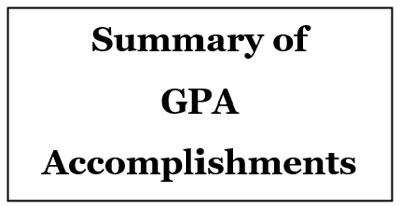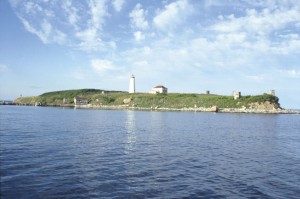The Guilford Preservation Alliance is proud of its role in helping to restore the lighthouse on Faulkner’s Island. The project began in 1990 as a commission of the Guilford Preservation Alliance (GPA). In November, 2009, the Faulkner’s Light Brigade received approval from the IRS to obtain independent status as a 501 (c)(3) entity. A description of the success of this project as of 2003, written by Joe Arnold, appears below. Current information abou The Faulkner’s Light Brigade can be found on their website at http://www.lighthouse.cc/FLB/.
The Faulkner’s Light Brigade, a commission of the Guilford Preservation Alliance (GPA), was formed in 1990 in the effort to restore the lighthouse on Faulkner’s Island in Long Island Sound and control the erosion that was threatening the island’s survival. With the projects well under way and having enjoyed much success, the Faulkner’s Light Brigade continues to aid the Faulkner’s Island cause through fundraising and education.
The Beginning
In 1990 the state of Faulkner’s Island lighthouse looked bleak. The accelerated erosion on the east bluff of the island was threatening the foundation of the lighthouse, the 1976 fire that destroyed the adjoining lightkeeper’s house blackened most of the south side of the lighthouse, the Coast Guard had abandoned its manned station, and vandals had broken windows and the main doorway in the tower.
Years earlier, Joel Helander, a Guilford historian with a life-long affinity for Faulkner’s Island, acquired an acute sense that neglect and erosion were threatening the lighthouse revered by mainlanders and mariners. He realized that an action campaign was needed to halt the runaway erosion that was endangering this historic landmark. Believing that such a campaign must begin with awareness and appreciation, he published a definitive account of the island’s history in 1988. It sounded the alarm. In August 1989, he followed up by coordinating an “open house” on the island. This had never been done before and is now a celebrated, annual event.
In October 1989, Helander visited the island with George Gdovin, Guilford’s building inspector, whose association with Faulkner’s began with his service with the Search and Rescue Division of the U.S. Coast Guard’s Group Long Island Sound. Gdovin’s coast guard duties had frequently brought him to the island to deliver provisions. Seeing the extent of the erosion on his visit with Helander, Gdovin organized the Faulkner’s Island Research Project in February 1990 to develop a topographic survey map of the island. The Project affiliated with Little Harbor Laboratory, a non-profit marine research organization owned by Sally Richards. An intensive geomorphic study of the island in transition became the subject of his Masters thesis at Antioch University. The project, completed over five years in Gdovin’s spare time, provided critical scientific data that would support the cause of island preservation.
While Gdovin acquired the data needed to prove the need for erosion control, Helander sought to gain recognition of the island by the National Register of Historic Places. With aid and advice from Al Hollingsworth, then president of the Guilford Preservation Alliance, and from the Connecticut Historical Commission, this effort was successful and Faulkner’s Island was listed on the National Register of Historic Places on May 29, 1990. This listing provided recognition of Faulkner’s as a cultural resource worthy of preservation at the national level.
Throughout that year, Hollingsworth persuaded the Guilford Preservation Alliance Board to create a bond with those who were then beginning to work together to move the Faulkner’s Island effort forward. As a result, Faulkner’s Light Brigade (FLB) became a commission of the GPA, and the GPA backed that relationship by providing seed money at this critical time.
As a commission, FLB was authorized to establish its own operating rules, a separate budget and fund raising procedure, as well as its own membership. As a commission, FLB is included in the GPA’s non-profit status with the state of Connecticut.
In 1991 Joel Helander was elected the first chairman of the FLB. His name is synonymous with the FLB, having guided it through eleven years of extraordinary accomplishments. The foremost of these is the fundraising for the erosion control project on the east side of the island.
The Erosion Project
The project began with enlisting the cooperation of our congressional representatives–Senators Joseph Lieberman and Christopher Dodd and Congresswoman Rosa DeLauro–in obtaining the funding for this project. Budget battles in Washington were joined, waged, won, lost and waged again. Congresswoman DeLauro championed the Faulkner’s Island appropriation when it stalled in the House. She came to the rescue of the appropriation and at a critical last minute, with the Bill nearly dead, she saved it.
With help from the Connecticut Trust for Historic Preservation and the National Trust for Historic Preservation, in September 1996 Congress appropriated part of the WRDA erosion control funds. The balance of the $4.5 million was appropriated in 1998 securing a future for Faulkner’s Island.
Then in 1999, when language technicalities in the Connecticut environmental permitting process again delayed the erosion control project, State Representative Patricia Widlitz stepped in and lent a guiding hand.
The U.S. Army Corps plan for preservation, designed to withstand a 50-year storm, became reality in September 2000 when an armada of heavy construction equipment arrived on the island under the direction of Zenone, Inc., low bidder for the project.
The erosion project was a unique engineering accomplishment with major problems and disasters. A floating wharf was built of heavy barges held in position by giant mechanically driven steel posts. Heavy equipment, trucks, bulldozers, and cranes were brought in. A temporary road was built across the island to the eastern bluff, the site of the erosion. A ramp was made for trucks that brought the stone and other materials used to shore up the eroding bluff.
The U.S. Fish and Wildlife Service (FWLS), which inherited the control of the island in 1985 from the departed Coast Guard, required that work be limited to the months of September through April. This limitation was imposed to protect endangered species of terns during the May through August breeding season.
Storms twice hurled the barges against the shore, sinking some and delaying the project for many weeks. The work was completed in 2001.
In 1997 the FLB joined forces with the Town of Guilford as a municipal partner. This partnership was a necessary move since federal funding required a public entity to supervise the distribution of funds.
Lighthouse Restoration
Under First Selectman Edward Lynch, the town applied through the Connecticut Department of Transportation for Intermodal Surface Transportation Enhancement Act (ISTEA) funding. This won $250,000 for lighthouse restoration. The Town commissioned Sally Richards as chair of its Lighthouse Restoration Committee, responsible for the administration of the funds. The FLB contributed $50,000 toward the funding, thus reducing the ISTEA’s contribution to $200,000.
Walter Sedovic Architects of Irvington, New York were chosen to perform the restoration project. Sedovic has said, “Historic buildings have a layering of time and events that’s irreplaceable… I think it’s remarkable to be working on a lighthouse that Jefferson commissioned and represents that period so well.” Sedovic chose to restore the tower to the 1871 period.
International Chimney Corporation of Buffalo, New York–the same company that moved two Cape Code lighthouses, among others–was chosen to implement the restoration of the lighthouse. The restoration includes a new ventilation system, the application of an all-white breathable coating to make the tower weather tight, painting of the lantern gallery inside and out, a new lightning protection system, installation of a stainless steel door, new 12-pane casement windows in the face of the west wall, restoration of the original weathervane, and the scraping and painting of the interior handrail. Another major addition is a 75-square foot entry deck. The project was completed in 1999.
Stairway Project
In 1996 the FLB received grants totaling $10,000 from The Women’s Seamen’s Friend Society of Connecticut and the Norcross Wildlife Foundation to be used for the replacement of the dilapidated concrete stairway from the island’s dock to the top of the island. The request was granted and a weather resistant tropical hardwood stairway was built by Jonathan Wuerth, a local restoration contractor.
Making It All Work
All of these projects required a prodigious amount of negotiation. The many federal agencies, including Congress, the U.S. Fish and Wildlife Service, the Coast Guard that still maintained responsibility for operating the light in the tower, and the Army Corps of Engineers which supervised the erosion project, all had a voice in the projects. In addition, state agencies were involved including the Department of Transportation and the Department of Environmental Protection. And finally, there were several Town agencies with which to contend in all these activities. Each of these governmental units had their own agenda and, as to be expected, they were often in contention. It is not too unrealistic to recognize that without the patient but persistent negotiating of our FLB chairman and Board members assigned to these projects, some of the projects would not have been realized.
The Fish and the Wildlife Service
The light station on Faulkner’s Island became a research station soon after the fire, with research on the endangered Roseate Tern, which nests there. An Act of Congress in 1984 established the Connecticut Coastal McKinney National Wildlife Refuge, of which Faulkner’s Island became an important component. Since Faulkner’s was already owned by the U.S. Government, its acquisition proved to be the least complicated of the island components of this refuge. It did not have to be purchased, but transferred in jurisdiction, from the U.S. Coast Guard to the U.S. Fish and Wildlife Service within the U.S. Department of Interior. Now the island’s custody is relegated back to the wilds of Mother Nature, although the Coast Guard reserves an easement to maintain its aid to navigation.
Friends Agreement
The future for the FLB is inextricably involved with work of the Fish and Wildlife Service on Faulkner’s Island. Future projects such as repair of the wharf and an easy-access, floating dock for public use would require a collaboration. Towards this end the FLB and the Fish and Wildlife Service have negotiated a formal “Friends Agreement” that will facilitate this collaboration.
The “Authorization” statement of this documentation with “Service” referring to the FWLS and “Brigade” to the FLB sums up objectives of the agreement as follows:
“The Service authorizes the Brigade to help plan and coordinate, and the Brigade agrees to help plan and coordinate ‘open houses’ on the Refuge for the visiting public on such dates that are approved by the Service. Furthermore, the Service authorizes the Brigade to conduct other activities and projects on the Refuge that are consistent with island preservation and/or the advancement of interpretive, education, recreational, and biological support services to the visiting public and the Service to be approved by the Service on a case basis.”
Anniversary Celebration
In addition there are special events, of which the 200th anniversary of the lighthouse was a prime example and is described as follows:
“With much thanks to benevolent weather gods and a determined planning committee, under the stern direction of chairmen Ginny and Charlie Baltay, the 200th anniversary of Faulkner’s Island was celebrated in grand fashion on Saturday and Sunday, September 7th and 8th, 2002.
Overall, an estimated 2,500 attendees participated in an array of activities including five round trips around the island on the schooner Quinnipiack, an informational program by the Fish and Wildlife Service for those fortunate enough to visit the island, and a fascinating program at Guilford’s Jacob’s Beach.
This was truly a community celebration, and the planners for the event were up to the challenge. The program on Saturday evening at Jacob’s Beach included songs of the sea by the Guilford High School Voices followed by the locally renowned ‘Chantymen of the Ancient Mariners.’ A particularly poignant moment was a recollection of life on the island by former lightkeepers and their families recruited by Joel Helander from all over the country.
First Selectman Carl Balestracci, a life-long resident of Guilford, spoke eloquently about the significance of the lighthouse to Guilford life, and Congresswoman Rosa DeLauro commended the Bicentennial Celebration as an event that strengthened community bonds.
And what better way to end the historic event than a dramatic 23 minutes of fireworks shot over the town harbor from Grass Island illuminating spectators at Jacob’s Beach and the town marina and those aboard the schooner moored at the state dock.”
The Future
The FLB’s future is dependent on maintaining an active membership, which presently is close to a thousand members. To promote a continuing interest, the FLB publishes the Octagon, a semi-annual newsletter that describes present and future projects. In addition, every spring they offer a lecture series in the Guilford Community Center. And in the fall, usually the first weekend in September, they offer an “open house” on the island inviting the public to a program conducted by FWLS, FLB and U.S. Coast Guard.
In March 2002 the FLB’s founder and chairman, Joel Helander, retired. The newly elected chairman, Fred Farnsworth’s first order of business was to propose to the Board of Directors that Joel be elected chairman emeritus. The proposal passed unanimously.
The Brigade’s future looks bright. “We won’t let the light go out.”
— Joe Arnold, February 2003




